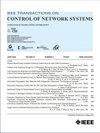Asynchronously Integral Event-Triggered Formation Tracking in UAV Swarm Systems Featuring Switching Directed Topologies
IF 5
3区 计算机科学
Q2 AUTOMATION & CONTROL SYSTEMS
引用次数: 0
Abstract
This article explores the control problem of integral event-triggered具有交换有向拓扑的无人机群系统的异步积分事件触发编队跟踪
本文探讨了具有切换定向拓扑的无人机(UAV)群系统的积分事件触发$\mathcal {H}_{\infty }$时变编队跟踪(TVFT)控制问题。采用持续停留时间(PDT)切换方法,可以保证群系统的非加权$\mathcal {H}_{\infty }$性能,提高了扰动衰减能力,这在现有的无人机编队控制研究中很少得到研究。同时,设计了一种更先进的积分事件触发机制(IETM),与静态事件触发机制相比,进一步降低了触发频率。此外,还考虑了由事件触发传输和切换特性共存引起的异步性。在此基础上,开发了一种综合的方法,将TVFT控制方案、IETM和PDT切换集成在一起,仿真结果验证了其有效性和优势。
本文章由计算机程序翻译,如有差异,请以英文原文为准。
求助全文
约1分钟内获得全文
求助全文
来源期刊

IEEE Transactions on Control of Network Systems
Mathematics-Control and Optimization
CiteScore
7.80
自引率
7.10%
发文量
169
期刊介绍:
The IEEE Transactions on Control of Network Systems is committed to the timely publication of high-impact papers at the intersection of control systems and network science. In particular, the journal addresses research on the analysis, design and implementation of networked control systems, as well as control over networks. Relevant work includes the full spectrum from basic research on control systems to the design of engineering solutions for automatic control of, and over, networks. The topics covered by this journal include: Coordinated control and estimation over networks, Control and computation over sensor networks, Control under communication constraints, Control and performance analysis issues that arise in the dynamics of networks used in application areas such as communications, computers, transportation, manufacturing, Web ranking and aggregation, social networks, biology, power systems, economics, Synchronization of activities across a controlled network, Stability analysis of controlled networks, Analysis of networks as hybrid dynamical systems.
 求助内容:
求助内容: 应助结果提醒方式:
应助结果提醒方式:


